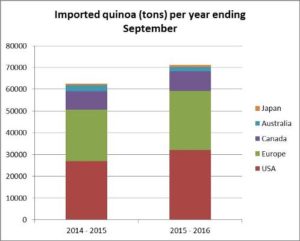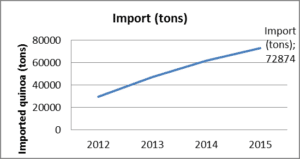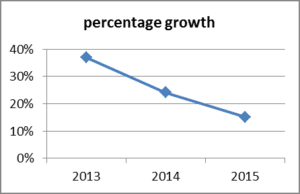Global quinoa imports continue to grow, although not as fast as in the previous years. The latest trade data show that quinoa imports in the world reached a total of 75,208 tons in the year ending September 2016, which is 13% more than in the previous year (Figure 1).

In calendar year 2015 the increase was 15% compared to the year before; in 2014 24% and in 2013 37%. So the growth in global trade is clearly flattening (Figures 2 and 3).


Both Europe and USA show an increase of quinoa imports in the year ending September 2016, of 15% and 19% respectively. However, quinoa imports in Australia went down with 28% from 2,715 to 1,965 tons. This appears to be related to a strong increase of quinoa production within the country. In 2011-2012, total Australian quinoa cultivation was estimated at 50 hectares, producing 45 tons of quinoa. In 2015 quinoa production in Australia reached 1,000 tons. [1]
Global quinoa production in 2015 was 228,870 tons [3], while quinoa imports reached a total of 72,874 tons[2], which is 32% of the production. This means that most quinoa is consumed in the country where it was cultivated. Quinoa cultivation is spreading to more and more countries, and the production within these new quinoa producing countries is increasing. Hence, these countries become less dependent on imports for their quinoa supply. Nevertheless, Peru, Bolivia and Ecuador are still by far the main quinoa producing countries. In 2015 these three countries accounted for 94% of total global quinoa production [3]. In the cropping season 2016 – 2017, however, Bolivian quinoa production is expected to be much lower. At Mercadero we predicted a drop of about 50% in our recent news article:
Mercadero has been investigating the global quinoa market for several years and initiated a new research project in the summer of 2016. The aim of this research is to gain a thorough insight in the actual supply and demand of quinoa in the world, with the purpose of developing a market forecasting model. In the coming months we will publish articles presenting our findings about quinoa global supply and demand. Our aim is to generate unique market intelligence and share this with stakeholders, in an effort to strengthen this emerging sector in a sustainable manner and benefit producers, exporters and consumers.
[1] Source: RIRDC Australian Government
[2] Source: ITC Trademap
[3] Source: Informa Agribusiness Intelligence, 2016
